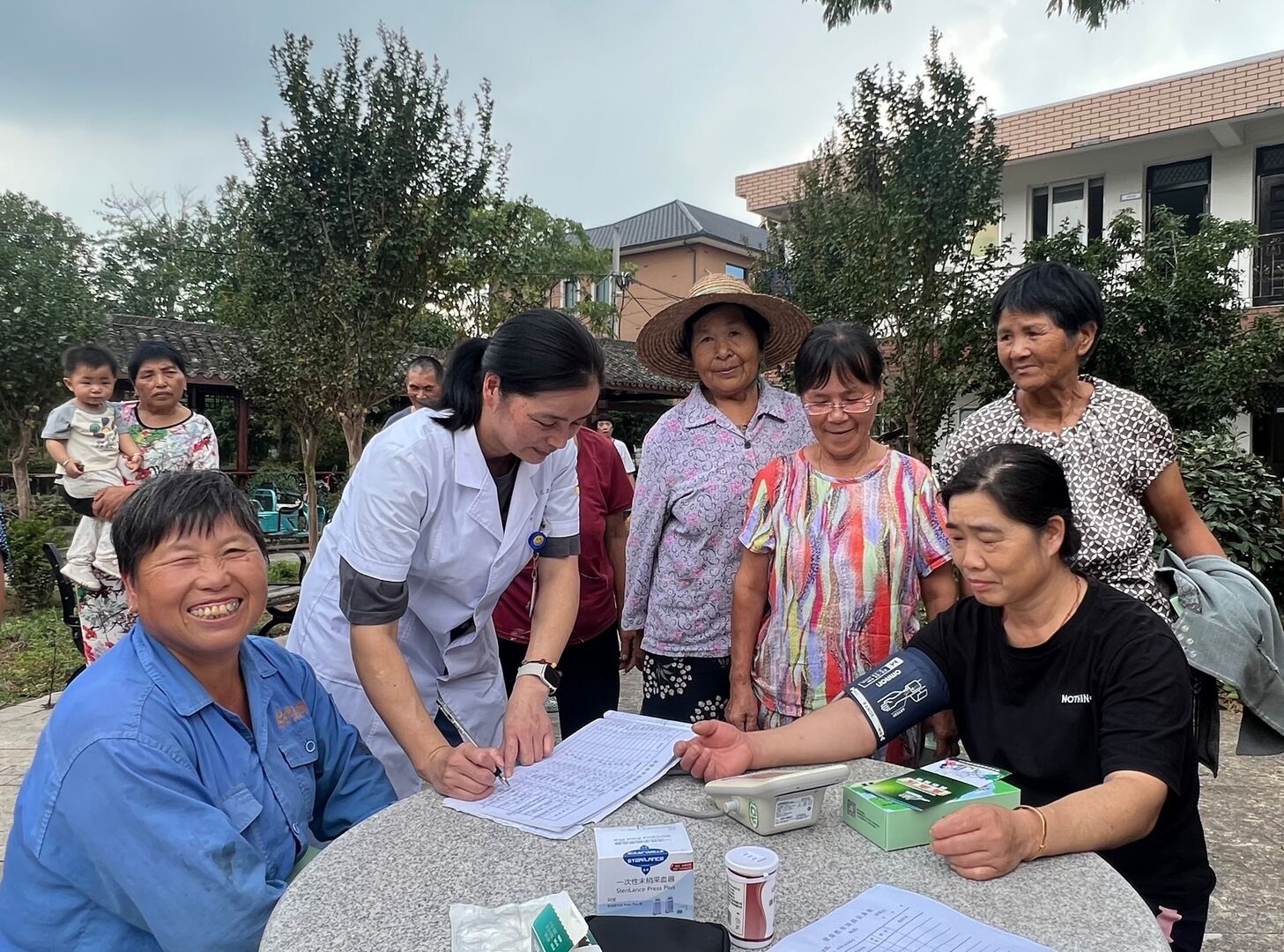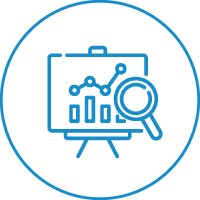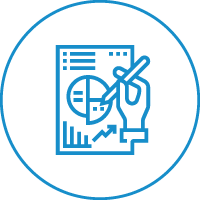Data are captured using Computer‑Assisted Personal Interviewing (CAPI) to ensure speed, accuracy and security.
Global Ageing Population Survey
The Global Ageing Population Survey (GAPS) is WHO’s flagship international epidemiological survey designed to collect globally comparable data on healthy ageing.
Using standard survey tools, GAPS comprehensively assesses older persons, their families, and the communities in which they live. The survey generates actionable data to evaluate the impact of national policies, strategies, and programmes aimed at enhancing the health and well-being of ageing populations worldwide.

A community health care worker in Deqing, Huzhou City (one of the PCIC pilot cities) visits residents' home to measure blood pressure as part of the non-communicable disease screening and follow-up services.
Background
Aims and Objectives
Overarching objective
The overall aim is to collate and analyze valuable data determinants outcomes of healthy ageing (Intrinsic capacity and functional ability) that can be effectively utilized to formulate impactful policies and programs, assess the efficacy of public health actions fostering healthy ageing to enrich the lives of older persons, their families, and the communities in which they live.
Specific objectives are:
- To provide globally comparable, actionable data to inform policies and interventions aimed at promoting healthy ageing and ensuring no older person is left behind.
- To explore and document the diverse patterns of healthy ageing and identify the determinants that contribute to differences in outcomes among older persons globally.
- To build the capabilities of WHO Member States, especially in low- and middle-income countries, for conducting robust epidemiological survey and utilizing data to guide national ageing policies.
- To establish a robust infrastructure, including the WHO GAPS Biobank, to facilitate advanced research using multi-omics methods, AI, and other innovative analytical techniques.
- To generate evidence-based insights that enable policymakers and stakeholders to implement targeted, effective strategies that enhance health, well-being, and equity among ageing populations worldwide.
Features
WHO-GAPS Core
WHO-GAPS Core Plus
WHO-GAPS Core AI
GAPS Core is a basic survey module suitable for low resourced settings. It includes self-reported survey questionnaires that comprehensively cover information from households, individuals, and caregivers, capturing core data on older people's living conditions, health conditions, health and long term care service coverage, health behaviors, risk factors, care arrangements and support.
Expands the Core survey by integrating detailed physical examinations using standardized medical devices and WHO-developed apps to objectively assess health status. It also features a biorepository (biobank) that stores biospecimens to support advanced biomedical research and insights into the biological factors influencing healthy ageing.
Building on GAPS Core+ survey, utilizes cutting-edge artificial intelligence for real-time health monitoring, predictive analytics of health trajectories, and early identification of at-risk older populations, enabling proactive and targeted public health interventions to support healthy ageing and healthy longevity.
Methodology


Design: Multi-wave cross-sectional survey with a nested longitudinal cohort.
Sample: Nationally representative samples of individuals aged 60 years and above. Sample sizes will be calculated based on selected health indicators, adjusted appropriately for potential non-response.
Interviews: Conducted face-to-face in participants' homes by pairs of trained field investigators. Proxy interviews will be carried out for older persons who are non-capacious or unable to participate.
Data Collection Frequency: Every three years
Case Studies
GAPS Survey Manuals
| Module | Domains of interest |
|---|---|
| Household interview | Housing, electricity, water, sanitation, indoor air pollution, number of residences, household consumption, household expenditures, ownership, household assets, household income, financial status of the house, environmental hazards & safety, overall financial situation and geospatial |
| Individual interview | Demographic, current occupation and work history, functional assessment, support for personal care, life-space mobility, anthropometric measurements, physical performance, cognitive function tests, risk factor and health behavior, nutritional intake, physical activity, health conditions, coverage of treatments, current medications, intrinsic capacity, functional ability, enabling environment, depression, frailty, impairments, health service utilization and satisfaction with health care, social network types and support, community participation, neighborhood safety, ageism, loneliness, abuse, life satisfaction and well-being |
| Caregivers interview | Demographic information, care dependence, cutting-back from work, time spent in caregiving activity, care arrangements, caregiver’s health, caregiving burden and caregiver subjective well-being |
Data collection tool
Platform: CSPro 8 with CSentry on Windows laptops and the CSPro Android Tablet app—all synchronized to a central server in real time.
Devices: Lightweight, secure Android tablets with offline capability for remote areas; encrypted data upload once connectivity is available.
Languages: English and Arabic interfaces are built‑in, with rapid localisation for other national languages to guarantee cultural and linguistic relevance.
Consistency controls: Automated skips, range checks and validation rules prevent entry errors at the point of interview.
The CAPI programme enhances the quality of data collection by minimizing transcription errors, accelerates data availability, and supports high‑quality, comparable data across countries implementing the GAPS.
Data analysis
GAPS Diagnostic Engine (GAPS Dx) is WHO’s purpose‑built survey algorithm that turns complex national ageing‑survey data into instant, policy‑ready intelligence.
End‑to‑end rigor. Automatic cleaning, missing‑data triage and validation guarantee rock‑solid datasets before analysis begins.
All indicators, one click. Demographics, employment, work history, income, household wealth, living conditions, access to basic household services, health behaviors, insufficient physical activity, chronic diseases, multimorbidity, polypharmacy, geriatric syndromes, impairments, health care service coverage, long‑term‑care needs and coverage of services, healthy ageing ( intrinsic capacity, functional ability, enabling environment), social isolation, ageism, abuse, wellbeing, care dependence and family caregiver’s health—GAPS Dx generates them all automatically.
Action‑focused visuals. Interactive dashboards distil trends and red‑flag risks so decision‑makers see what matters in seconds.
No one left behind. Outputs highlight vulnerable population sub-groups and regional gaps, guiding resources where they needed most.
With multidimensional insights, GAPS Dx arms governments and researchers with the evidence they need to design public services and deliver more equitable healthy ageing for everyone.
Ethical considerations
Ethical considerations for the WHO-GAPS include ensuring informed consent and maintaining data quality control. Participants will be provided with detailed consent forms, and alternative methods will be available for those unable to read, such as verbal explanations and signatures or fingerprints.
Data quality control
Data will be collected using Computer Assisted Personal Interview (CAPI) software, with rigorous quality checks and real-time monitoring to ensure accuracy and reliability.
Outcomes of interest
The WHO-GAPS aims to measure the prevalence of various health conditions, assess levels of disablement, and evaluate care arrangements and their impact on caregivers. The survey also includes a healthy ageing metric that combines intrinsic capacity, functional ability, and environmental characteristics, allowing for cross-country comparisons to evaluate the state of healthy ageing across different populations.
Publications
News
Contact us
